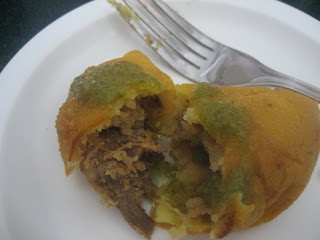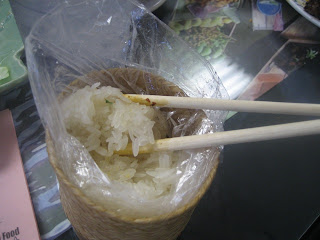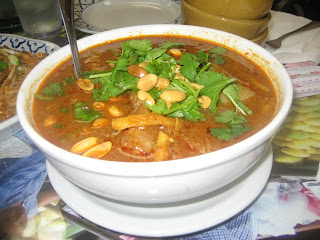Tapas.
You’re groaning right now, I know it. And you’re rolling your eyes, too, right? Yes, tapas are trendy (although I think we’re on the backside of that wave now), but I’ve always thought the idea of tapas made great sense. A few small plates shared amongst a group of friends is a smart way to sample more dishes than you can or should consume in one sitting.
I first heard of tapas a dozen or so years ago, when Himself’s parents went to Spain for a few weeks and returned with a whole new food vocabulary (they got a lot of mileage out of making it sound like they’d been to topless bars all over Madrid and Barcelona!). They were impressed by the logic of the tapa, and I am, too. A small plate with a few bites of food sitting on top of your drink–that’s the way they do it in Spain, where tapas were born. While they were originally intended to provide a little pre-dinner nosh with your post-workday drink, an assortment of tapas makes it possible to eat all you need to see you through to breakfast tomorrow. Maybe the Spanish can eat dinner at 10 p.m., but I can’t!
I looked around LA for a restaurant with an enticing menu and found The Three Drunken Goats, which has an enticing name as well. It refers to the practice of washing goat cheese with wine before it is put back for aging. There were no goats in this Montrose restaurant when we were there, either drunk or sober (or on the menu). I don’t know if I was more disappointed about that or relieved.
golden beets with arugula, hazelnuts and goat cheese
We started with a salad of golden beets and arugula, topped with toasted hazelnuts and herbed goat cheese. The sweetness of the beets, the bite of the arugula, the richness of the hazelnuts and the tang of the cheese made each bite a perfect little harmony in my mouth. Just lovely, like a late summer day.
mushroom tapenade with goat cheese and crostini
The mushroom tapenade did the same, but in a different way, with richer, more autumny flavors and the slightest bite from the piquillo, flavorful without being spicy hot. This tapa included a bit of goat cheese too, and its tartness helped cut through the unctuousness of the tapenade (uh oh, I just said “unctuousness.” I swore I’d never employ overused food-writing words like “unctuous” and “eponymous.” This is worse than belching loudly in the middle of the restaurant!)
patates topped with cabrales and served with aioli
And then there was winter… The patates were my favorite tapa. They were smooth and rich, made moreso with musky truffle oil and cabrales, a lovely blue cheese (a triple punch of cow’s, sheep’s and goat’s milk), softened by the heat of the potatoes. With aioli to dip them in. I could have ordered a couple more servings and eschewed the rest of the menu items. But I’m glad I didn’t. There were still lamb chops to come…
lamb chops with chickpea, mint and garlic purée
…and they were delicate and quite fine all on their own. The chickpea purée wasn’t really necessary, but it was good, so we anointed the chops with it just the same. (I still can’t pick up a Frenched bone in a restaurant without thinking of the poor soul in the back of the house who’s scraping and scraping. Thank you, poor soul!)
Basque salad with roasted garlic and grilled bread
The Basque salad with roasted garlic and crostini was a nice marriage of light and fresh with rich and earthy, sort of like early spring. To be honest, the lettuce was almost a needless distraction from the superstar, all that lovely caramelized garlic, which I could have just squeezed right into my mouth, without the benefit of the bread to carry it there daintily. Not to disparage the crostini, though, which showed up on several of the plates. Makes me want to set my toaster oven out on the curb. Grilled bread is tasty stuff. (On a side note, I’m not sure why they called it Basque salad, as there were no discernible elements of the Basque table represented in this tapa, not even a hint of anchovy in the Caesar dressing.)
churros with bittersweet chocolate
The churros were simply amazing. I’ve had them in Mexico City, where they know a thing or two about frying sweets, but these were much lighter–while still being really rich. The chocolate for dipping was slightly bitter and slightly sweet, a nice balance. It was a great finish to our meal. To drink, Himself had cali mocho and I had sangria, the way the Spanish make it. It was much tastier and more well balanced than the typical cheap-wine-and-fruit-juice-in-a-pitcher-with-some-fruit-slices-chucked-in. And I was glad to sample the cali mocho and see how the Spanish make it. It tasted like a combination of about 3-to-1 cola and red wine, really refreshing on one of the last hot days of this summer.
We decided to veer from the ubiquitous paella and gazpacho in favor of tapas, so we could try more dishes–and so I could write about more dishes. I feel a little guilty posting a Spanish meal with no seafood in it. As much water as there is surrounding Spain, it’s rare to find a meal without at least a shrimp or an anchovy tossed in. The possibilities for tapas are practically unlimited, so this is scarcely a representative sampling. We decided against a plate of cheeses, as happy as that would have made us. No jamon or other Spanish cured meats. But the sheer variety of choices is one of the best things about tapas. I don’t think I could ever get bored with them. One meal could be boquerones, croquetas and peppers stuffed with dried cod. And the next mussels, bunuelos and albondigas. Or clams or fresh tuna with beans and olives. Or squid and baby octopus. Or stuffed calamares. Or one of an endless array of salads.
I need to find a non-tapas restaurant sometime during my 52 Cuisines sojourn, so I can represent a little more fully the bounty of Spain’s table. I could easily write 52 blogs on just about any one cuisine I’m sampling during this adventure. The downside is that I never feel I’m doing justice to any cuisine in these entries. But the upside is that there’s so much more to explore, write about and enjoy.




















